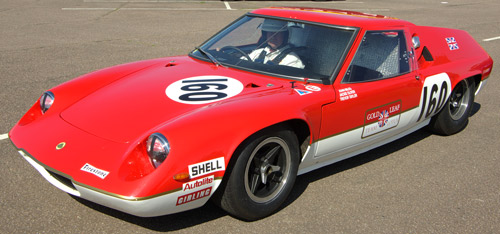
John Bolding
 |
Historic Lotus Register | Lotus 47 John Bolding |
|---|
4 Brook Road, Gidea Park
ROMFORD
Essex RM2 5QT
Telephone: 01708-744743
To send e-mail click on name above
John is Registrar for the Lotus 47
| Lotus 47 - The Competition Europa |
|---|
 |
| How it started: The Lotus Type 46 Europa |
In January 1965 Colin Chapman wrote to Jabby Crombac, his French journalist friend, asking him for help in securing a supply of Renault 16 engines and gearboxes. This all-aluminium unit from the front-wheel drive 16 had struck him as ideal for use in a new mid-engined G.T. car he had in mind. Subsequently 500 of these units were acquired and formed the basis of the Lotus Europa revealed to the press in December 1966 but not yet for sale in the U.K. The car used a box section central spine chassis enclosed with glass-fibre bodywork actually bonded to the chassis to form a rigid monocoque structure. A similar technique had been used by Porsche on their successful 904 racer.
The new car, the Type 46 was very low, in fact as low as a Ford G.T.40, and the sleek slippery shape produced an excellent drag coefficient. The design by John Frayling incorporated a high cut-off back end, loosely reminiscent of the famed Ferrari 250 G.T. 'Breadvan'. The car was formally announced to the Press on December 20th 1966
| The Lotus 47 |
|---|
One week later two of the previously unseen Type 47 racing versions lined up side by side on the grid at the damp and murky Boxing Day Brands Hatch meeting. The two new white 47's finished first and second on the road in their debut race, with John Miles on his first works drive winning and Jackie Oliver finishing second, although demoted in the results due to a push start after stalling on the line.
The 47 was a very different animal to the road-going Type 46 and incorporated the brand new Hewland FT 200 (Formula Two-200 BHP) magnesium gearbox mated to the trusty Ford Cosworth twin-cam engine bored to 1590 c.c. for the up to 1600 class.
The magnesium rear uprights and radius arms were based on current Lotus single seaters. The cars ran throughout most of 1967 as group 6 cars until the required parts for 50 cars had been laid down to comply with F.I.A regulations for Group 4. They were also trimmed internally in accordance with F.I.A. requirements. The new Tecalemit-Jackson fuel injection system was installed as standard, but many private owners seemed to prefer the tried and tested 45 D.C.O.E. Webers. John Miles said in later years that he felt that the T.J. system had not given him any significant power advantage and could be troublesome when hot. The single works car in 1967 was prepared by Lotus Components and ran in white with a single green stripe throughout the year.
| The Lotus 47A |
|---|
For 1968 Lotus addressed the problem of the difficulty of crash damage repairs to the bonded chassis unit by the construction of two new cars with lift-off bodies in a manner similar to the Elan and Plus Two. Front and rear suspension modifications were incorporated, together with a removable engine firewall/bulkhead and a fully adjustable front anti-roll bar. Sponsorship from John Player resulted in the adoption of the Gold Leaf colour scheme on the two new cars, which were both built and run by 'Team Lotus', now as fully homologated Group 4 racers. These new cars were designated 47A's and it seems likely from photographic evidence that possibly only one or two other 47A's were constructed and raced by other teams. The bodies were moulded by Specialised Mouldings of Huntingdon.
It is believed that 71 chassis in all were built, and of these 5 were replacement chassis /body units for accident damaged cars, and 7 were designated 47F's with crossflow Ford engines and Renault gearboxes. One 47A body was used as the basis for the G.K.N./Vandervell commissioned 47D, a road-going V8 which served as a testbed and showcar for G.K.N. components.
The 47 was never designed as a road car although some were converted for road use and some found their way onto the road when their racing careers ended. Although the standard set-up was the Cosworth C.13 mated to the F.T. 200, many cars were supplied to owners and race teams without engines or gearboxes. Cars are known to have raced with Coventry Climax, Ford Crossflow, B.M.W., Cosworth F.V.A. (Four Valve Anglia), and later even V8's and in one case a Maserati Merak unit.
| The Lotus 62 |
|---|
By the end of 1968 John Miles and Trevor Taylor, who were probably the most successful racing exponents, could not keep pace with the best of the developing F.V.A. engined Chevrons. Lotus had already effectively ceased production of the 47 and had started to construct two new cars for the 1969 season which would become the type 62 prototypes, racing testbeds for their new 2 litre 4 cylinder LV 220 engine which would eventually be developed into the unit which powered the Excels and Esprits for the next 25 years. Although the 62s outwardly still resembled the Europas, to promote sales of the new S2 Europa which was about to be marketed in the U.K. , they were actually of spaceframe construction.
| Lotus 47 Racing |
|---|
47s raced in the U.K., U.S.A., Portugal, Holland, Belgium, France, Germany, Sweden, Spain, Angola, Italy and Japan . They took part in most of the long distance races of the time including the B.O.A.C. 500, where John Miles and Jackie Oliver won their class for two years running, together with Le Mans, Sebring, Daytona, Watkins Glen, Nurburgring, Spa, Villa Real, Avus and the Targa Florio. Cars carried on racing into the 1970's but were by then increasingly outclassed.
Mention must be made of the very successful 47F campaigned by Paul Kerridge in the Players No.6 Autocross series. This car will be remembered by all who saw it, resplendent in Bottle Green Velvetex paint with a broad yellow stripe. Despite a hard and destructive racing career this car survived and is now fully restored and racing again .
Notable 47 drivers included John Miles, Jackie Oliver, Trevor Taylor, Tim Schenken, Jim Morley, John Hine, David Preston, John Wagstaff, Julian Sutton, John Blades, Simon De Latour, Carlos Santos, John Calvert, Dave Walker, Peter Gaydon, Kieth Holland, Victor Walker, Ted Bunce, Rex Bates, Mike Crabtree and Ernesto Neves.
In conclusion, the 47 had a number of firsts to its name, both in racing and development, and produced many exciting racing moments as anyone who saw John Miles, Jackie Oliver or Trevor Taylor at full chat dicing with G.T. 40's and 2 litre Porsches will testify. The final analysis I'll leave to John Miles:- 'A little understeery on some circuits, but, all in all, one of my favourite racers'.
John Bolding October 2006